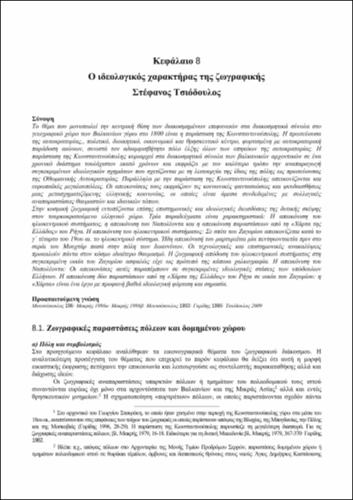| Title Details: | |
|
The ideological character of the mural painting. Painted Depictions of cities |
|
| Authors: |
Tsiodoulos, Stefanos |
| Reviewer: |
Sampanikou, Evangelia |
| Description: | |
| Abstract: |
Around 1800, in the Balkans territory, the theme that monopolizes decorative surfaces and ornamental ensembles is Constantinople, the capital of the Empire, the political, administrative, economic and religious centre that would become overwhelmed with imperial traditions for centuries to come. Constantinople is an undeniable attraction for all of the empire’s nationals. Illustrations of Istanbul would dominate the decorative ensembles in Balkan mansions for a period of at least one hundred years. Illustrations centred on the capital perfectly express the recreation of specific ideological forms associated with the city’s functions as the capital of the Ottoman Empire. Alongside depictions of Constantinople are illustrations of European cities. These illustrations reflect social fantasies and illusions of an amalgamated Greek society, which is directly linked to the collective representations of admirable sites and ideal places. In folk art, there is equally a scientific yet ideological penetration of Western thought in the Turkish invaded-Greek region. There are three representative examples: An illustration of the heliocentric system, a representation of Napoleon and a pictorial display of Riga’s “Charter of Greece.” First let’s consider the illustration of the heliocentric system. In the third quarter of the 19th century there is a depiction of a heliocentric system in a home of the Zagori region. Already, this illustration shows a half century prior to the seraglio of Mukhtar Pasha in the city of Ioannina. Moreover, technological and scientific discoveries always provoked great admiration in the world. The art creation of the heliocentric system found in a house of the Zagori region certainly used a copper-engraving model.
|
| Linguistic Editors: |
Karampalis, Spyridon |
| Technical Editors: |
Zinas, Nikolaos |
| Graphic Editors: |
Koumartzis, Nikolaos |
| Type: |
Chapter |
| Creation Date: | 2015 |
| Item Details: | |
| License: |
Attribution - NonCommercial - ShareAlike 4.0 International (CC BY-NC-SA 4.0) |
| Spatial Coverage: |
Ελλαδικός χώρος |
| Temporal Coverage: |
19ος αιώνας |
| Handle | http://hdl.handle.net/11419/3932 |
| Bibliographic Reference: | Tsiodoulos, S. (2015). The ideological character of the mural painting. Painted Depictions of cities [Chapter]. In Zarra, I., Merantzas, C., & Tsiodoulos, S. 2015. From Post-Byzantine to Modern Civilization [Undergraduate textbook]. Kallipos, Open Academic Editions. https://hdl.handle.net/11419/3932 |
| Language: |
Greek |
| Is Part of: |
From Post-Byzantine to Modern Civilization |
| Number of pages |
19 |
| Publication Origin: |
Kallipos, Open Academic Editions |

